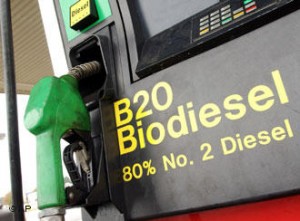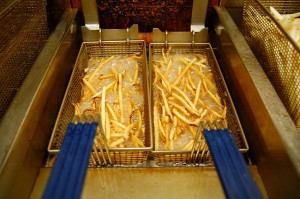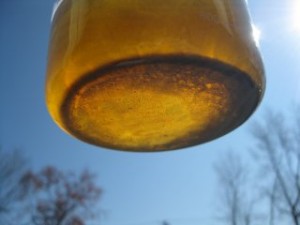This time of year we always see a surge in cities and counties contacting us to collect or receive their used cooking oil. Many people these days deep fry their turkey for Thanksgiving. It’s a quick, tasty way to cook a large turkey. I’ll leave it to the culinary experts to tell you how to best fry and serve the turkey on this day, but I want to share a few tips and ideas about the grease that comes from this collective holiday ritual.

Deep Frying a Turkey
It started for us about 3 years ago. We had calls from several cities a few months before Thanksgiving asking us if we would accept their cooking oil. We said yes. For some municipalities, it even turned into a curbside collection program where the city would pickup your grease (in sealed containers) from your house during the normal trash pickup. We started placing special collection bins at municipal and county waste collection locations. Now, picking up used cooking oil from a government entity isn’t a simple and trivial process. Most of them want a contract, which clearly states that we have insurance and other commitments to ensure that we will do what we say we’ll do, and transfer the liability to someone else if something bad happens. That’s just the nature of today’s society and working with any government entity.
You will see these programs labeled as “Municipal Curbside Grease Collection Programs” or “WVO Recycling Programs”. WVO (waste vegetable oil) and UCO (used cooking oil) can be used interchangeably and are often just stated as “grease” or “used oil”. Many times you will see WVO collected at the city or county hazardous waste facility, even though technically WVO is not hazardous waste (it is food, after all). Mostly they are put at hazmat collection sites because they don’t have anywhere else suitable to contain it, and those sites are used to handling liquids that can be a bit messy.
But why do these cities and counties want to sell me their grease? It doesn’t pay that much. In fact, the money we pay for the grease probably barely pays to offset the fuel and labor it takes to pick the oil up and transport it back to the recycling site (although we do sell biodiesel back at a discount to some which further enhances the savings).

FOG in a Sewer Pipe
No, the real reason is FOG. Not the London type, it stands for Fats, Oils, and Greases. It’s nasty stuff. It happens when people pour grease down their drains or in the sewer. Fats, oils and greases that are liquids at high temperatures cool and become solids. When they cool, it clogs up the drains or sewers, and creates backup issues that can create huge financial problems for people and businesses when their business or street floods with water and sewer. It’s nasty, it’s costly, and it’s a potential health concern.
There’s a special kind of truck, maybe you’ve seen them, called a “Jetter” that’s used to clean up this mess. These highly specialized trucks have a pumping system similar to a fire truck that uses very high pressure hot water to clear out the drain. In some cases, actually sucking the muck out into another tank so it can be dumped at a proper waste handling facility that is designed to process fats and oils. It’s a nasty job worthy of a “Dirty Jobs” episode all by itself (in fact, they did a sewer clean out episode, I think).
So really, the entire “UCO Recycling program” is to prevent FOG. It saves labor, time, and money, and it prevents very costly and potentially catastrophic sewer backups. Plus, the city or county is improving their recycling program and benefits by looking “green”. In some cases they actually are “green” because the biodiesel we produce from those oils is sold back to that group as biodiesel, which is used in their trucks and buses to reduce diesel exhaust emissions.
So in effect, the turkey you fry this Thanksgiving not only tastes good, it’s potentially helping to provide cleaner air for the city and county you live in. That’s something to be pretty thankful for indeed.
For more information about turkey frying and what to do with the grease after, we like the fact sheet provided by the Hampton Roads, VA FOG education committee. See it here: http://www.fatfreedrains.com/downloads/factsheet_TurkeyFrying09.pdf

A Jetter Truck Cleans Out Sewers
Here’s how to recycle your cooking grease after frying:
- After frying your turkey (or whatever), cover the cooker with the lid and allow it to cool for several hours, or until the temperature is at least below 110°F.
- If possible, find the original container the oil came in. These containers are usually plastic with a screw on top and are perfect for storing oil. Otherwise, find a suitable container that can hold the oil in an airtight and spill proof manner.
- Using a funnel, pour the oil into the container, getting as much as possible from the fryer into the container. Seal the container with the lid, and if necessary, use electrical tape or masking tape around the lid to ensure the lid will not come off accidentally. IMPORTANT: Label the container as “Used Cooking Oil” on several sides in permanent marker.
- With paper towels, wipe the inside of the fryer to get any residual oil and fryer bits, and wipe off any excess around the fryer oil container that may have spilled during transfer. Discard the paper towels in your trash. Some people burn them in the fireplace as kindling, but we don’t necessarily recommend that because it’s messy and can create an oily smoke that is not healthy to breathe.
- If your city has a curbside collection program, you may need to contact them in advance and tell them you have grease to pick up. Some cities have a minimum amount to pickup, so ask. Otherwise, place at your curbside where it will be seen during your normal trash or recycling pickup.
- If you don’t have curbside pickup, simply take it to your city or county recycling or hazardous waste facility for recycling there. You can also drop it off at our facility in Wilson if that’s convenient (see our contact page on our website for a map).
Don’t throw that grease away! It can be recycled and used to help make diesel fumes less toxic to our air!













